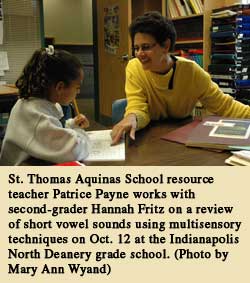2006 Catholic Schools Week Supplement
Multisensory techniques help resource students
By Mary Ann Wyand
 Windows of learning open easily for some students, but may not open at all for children who struggle with learning disabilities.
Windows of learning open easily for some students, but may not open at all for children who struggle with learning disabilities.
Parents share their children’s frustrations because they don’t know how to help them understand school assignments.
Resource programs and specially trained teachers at Catholic schools are an answer to prayers for many parents who want their children to attend a “mainstream” school.
St. Thomas Aquinas parishioner Patrice Payne of Carmel, Ind., has served as the resource teacher at St. Thomas Aquinas School in Indianapolis for 18 years and enjoys helping students discover their own unique ways to understand mathematics or learn how to read better using multisensory techniques.
Payne works with Peggy Linard of Indianapolis, who also is a resource teacher at the Indianapolis North Deanery grade school, to help students accomplish tasks they never dreamed they could do because of their learning disabilities.
Some students receive resource services once or twice a day, Payne said, while others only need extra help a couple of times a week for study skill support or an occasional consultation to check on their progress.
Each student’s learning needs are unique, she said, and every student is special. Some students learn best with the “pull-out” model in the resource classroom, and others can be helped with the “inclusion” model in the classroom.
“Recently, I read a report that said 4.4 million children have been diagnosed with attention deficit disorder in the U.S.,” Payne said. “That covers all age levels up to age 18. Researchers are also finding that more adults have attention deficit disorder than previously suspected.”
Learning disabilities can cause students to suffer from depression or struggle with self-esteem, she said. “It affects how students perform in the classroom and how their peers perceive them.”
At St. Thomas Aquinas School, there is no stigma attached to resource lessons, Payne said, and students enjoy spending time with “Mrs. Payne and Mrs. Linard.”
“We assist students in all subject areas as they progress through their years at St. Thomas Aquinas School,” Payne said. “Some students just need a little bit of help to get a jump-start on the year and then they’re fine, but usually those are the students who don’t have a diagnosed learning disability.”
Payne said the term “learning dis-ability” is “a kind of catch-all phrase” that covers many different kinds of special needs.
“As we do more research and learn more about the brain, we’re finding that it encompasses so much more than just cognition and learning,” she said. “Especially in terms of the spectrum disorders—autism or Asperger’s [syndrome], for example—we’re finding that there’s a lot of connections … where these conditions will exist side by side.”
She said various types of sensory activities can help students cope with their learning disabilities and figure out ways to increase their level of comprehension.
St. Thomas Aquinas School’s resource program earned its second national SPICE (Selected Program for Improving Catholic Education) Award from the National Catholic Educational Association (NCEA) last year.
Payne and Linard attended the 2005 NCEA Conference on June 24-26
in Boston to present a workshop about resource techniques that enhance learning skills.
Payne earned the school’s first national SPICE Award in 1997.
They are especially grateful to the Guardian Angel Guild in Indianapolis, whose members raise funds to support resource programs at Catholic grade schools in Marion County. The guild was founded in 1959.
“They have done so much to help the Catholic schools throughout the years,” Payne said. “They underwrite so much of the private tests that have to be done at St. Mary’s Child Center in Indianapolis, and that has helped parents who can’t afford to pay for tests for their children. The guild also supplied specially engineered sound therapy equipment to help us improve students’ learning modalities.” †
